Building a Smarter Workplace: How Flexible Office Spaces Benefit Employees and Businesses
Address evolving workplace and workforce requirements with innovative, adaptable technology
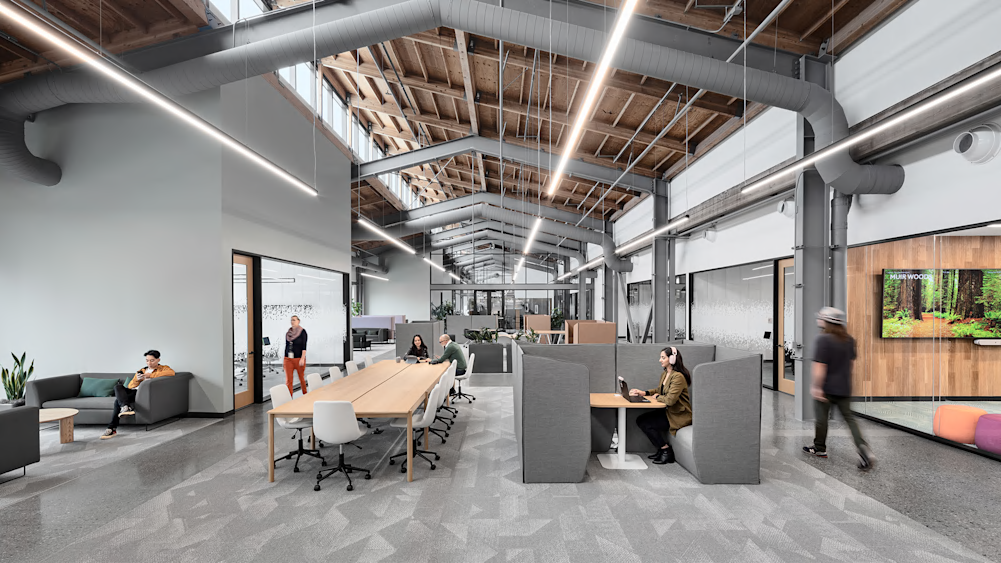
If you ask business leaders which technology will drive their companies forward in the next five years, most will point to Artificial Intelligence. It’s a smart choice. Done right, it can boost efficiency, reduce admin burdens, and empower employees to focus on what they do best. But there’s another investment with the power to transform the workplace just as profoundly – investment in the workplace itself.
A modern, adaptable, and thoughtfully designed workspace doesn’t just support productivity; it inspires creativity and attracts people to the office. Through smart, flexible workplace technology, organizations can deliver healthier workplace environments and elevated employee experiences while maximizing the value of office spaces.
But how?
This article explores the ways in which workplaces and workforces are changing, plus the innovative technologies helping businesses to adapt. From overcoming the challenges of flexible working to unlocking the opportunities smarter workspaces provide, we’ll dive into the solutions that can elevate your workplace and enable your business to thrive.
A new reality for office spaces
Today, simply providing a desk and a computer for every employee won’t cut it. The way we carry out tasks, approach office attendance, and interact with one another in a business setting has changed for good.
A recent survey carried out across 11 countries found that 44% of people prefer hybrid work environments, 39% want to be in the office full time, and 17% favor fully remote work. People now choose jobs based on the flexibility they offer; some long for the days of an in-office 9-5, while many would accept a lower salary if they could continue to work from home.
This diversity in preferences can make workplace design a challenge. However, the act of bringing people together in person remains as important as ever. The office must be an attractive, useful place that employees want to work from. They should be able to complete tasks without limitations and benefit from time spent alongside colleagues. The CCS Employee Workplace Technology Survey found that over half of employees said social interaction and a sense of community were the most important advantages of corporate offices. Meanwhile, 33% were concerned that a hybrid approach limited their ability to build work relationships. Remote employees can often feel isolated, with 43% reporting disconnection from their company, making them more likely to seek opportunities elsewhere.
Office spaces must be capable of meeting modern demands, whether employees are present occasionally or every day. For instance, over 50% of employees surveyed by Appspace said that going into the office “feels like a waste of time”. Many claimed that their offices didn’t support productivity and that too few colleagues were there for them to collaborate effectively.
In short, a one-size-fits-all approach to workplace design is no longer feasible. Companies must prioritize flexibility and employee experience to unlock significant benefits today, plus the ability to adapt as workplace requirements continue to evolve.
Workplaces designed for modern work
At Logitech, we’re tackling evolving workplace demands by leveraging data-driven insights to reimagine our office spaces. The redesign of our San Jose office focused on creating spaces that inspire productivity and support human connection while accommodating the shift toward smaller, video-enabled meeting rooms and flexible desk arrangements. We based our human-centric approach on lessons learned across our other global offices, helping to address logistical challenges as well as enhance engagement and innovation.
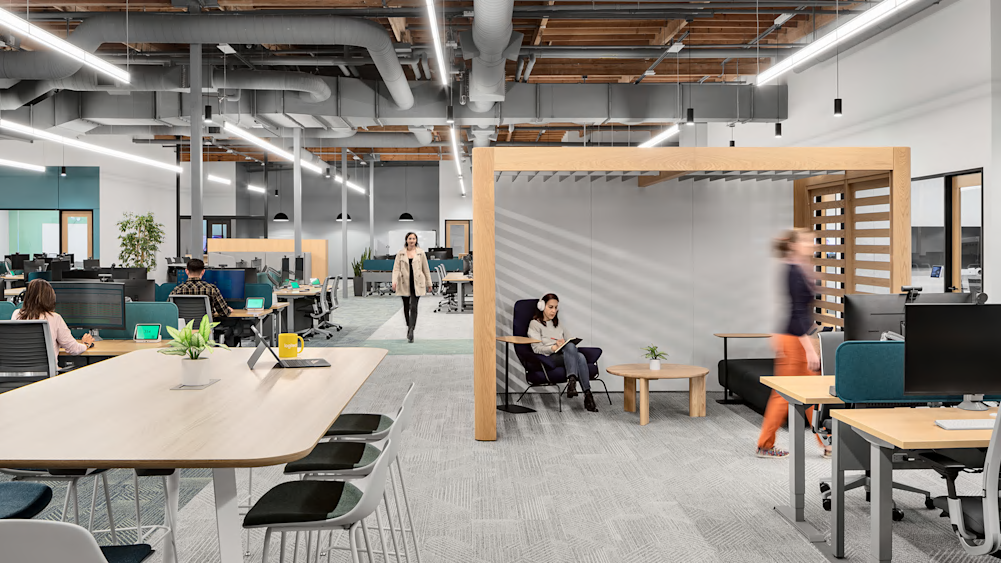
The Logitech San Jose office offers a range of workspaces, including flexible desk areas.
Similarly, the Neiman Marcus Group (NMG) has also embraced flexibility and human-centric design using Logitech technology. Its unique approach saw traditional corporate headquarters replaced with a network of collaboration-focused hubs. By prioritizing equity and accessibility, NMG ensures every employee, regardless of location, has access to an optimal work experience. Its flagship Dallas-Fort Worth hub redefines conventional office design, dedicating 70% of its space to collaboration and 30% to individual workstations. This “magnet, not mandate” philosophy draws employees to the office by choice, creating an environment that fuels productivity, connection, and flexibility.
However, changing requirements don’t only impact organizations that offer remote and flexible work. Even those requiring 100% on-site attendance must adapt their workplaces to ensure employees are supported throughout their work day. For large organizations, the scale and complexity of this task can make the transition particularly challenging.
Take Amazon, for example. A report by Business Insider on its return to work mandate underscores the difficulties of re-establishing full-time in-office operations after years of hybrid and remote work. In such situations, traditional workspaces may not be able to meet demand, with issues including insufficient desks, meeting rooms, and strained resources making a return to the office a struggle. It illustrates how even the largest organizations must carefully balance employee expectations and preferences with operational efficiency.
So, what are the next steps?
How organizations can rise to the workplace challenge
To ensure long-term success, organizations must rethink office spaces to meet the current needs of the business and its people.
Whether they are working flexibly or are in the office every day, employees want the spaces they work in to work for them. Long before flexible and remote work became prevalent, a study by Steelcase found that 95% of workers needed quiet, private spaces, yet only 40% said their workplaces provided them. The fact is, most employees require a range of environments, including quiet zones for deep focus, available desks for productivity, huddle areas for quick discussions, and larger, well-equipped spaces for collaborative meetings.
In today’s dynamic work environments, efficiency and convenience are essential. Organizations must offer diverse, flexible workspaces that accommodate different work styles and make daily tasks as simple as possible, with technology playing a critical role in enhancing them.
Key features of smarter workplaces
Seamless room and desk booking systems to ensure employees can easily find and reserve the spaces they need.
Collaboration technology that can be quickly moved between spaces to cater to different meeting needs.
Smart occupancy sensors that help manage shared spaces effectively, automatically releasing unused rooms to maximize availability and minimize wasted resources.
Integrated scheduling systems to keep employees informed, enhancing their ability to coordinate with colleagues and make the most of their time in the office.
Ultimately, a flexible workplace should be just that. The idea isn’t simply to implement and forget but to learn and adapt. Organizations have a responsibility to stay on top of trends and adjust spaces accordingly to ensure the best outcomes.
Approaches to monitoring and optimizing the workplace
Gathering insights on space and device usage to identify issues or areas for improvement.
Adjusting spaces according to shifting needs, such as fluctuating attendance levels.
Monitoring factors like air quality and room climate or energy efficiencies to promote healthier and more sustainable working environments.
Providing IT teams with tools to manage and monitor devices across multiple office locations to ensure the availability and effectiveness of spaces.
Now, let’s look at what that means in practice…
Redefining the workplace with flex spaces and flex desks
Flex spaces and flex desks have emerged as effective approaches to address changing workplace needs.
Flex desks are similar to “hot desking” and use shared desks to optimize office space effectively, especially in flexible work environments. By enabling employees to quickly find a place to work rather than operate from a permanent desk, flex desks ensure that fluctuating attendance can be catered for while maximizing the value of office-based technology. Solutions like Logi Dock Flex elevate such spaces. Serving as a managed docking station and desk booking system, it allows employees to view booking details and secure a free desk when they need one.
Meanwhile, flex spaces aren’t limited to desks. They are open-concept group collaboration spaces that include modular and moveable furniture and equipment. Multi-purpose flex spaces can accommodate teams of all sizes, from three to four people to more than 20. To streamline the booking process and minimize scheduling conflicts, flex spaces can be equipped with a scheduling panel like Tap Scheduler. This enables employees to view room availability and book spaces on the spot or in advance, whether they are video-enabled rooms or those dedicated to in-person interactions without additional technology. But fixed rooms aren’t always capable of flexing in a way that meets the demands of today’s workplaces. Adaptability is crucial, which makes the ability to create a flex space on an ad hoc basis an essential investment. This calls for flexible, portable, all-in-one solutions that can adapt effortlessly as businesses grow or adjust their layouts, integrating seamlessly into open spaces and small to medium rooms. Devices like Rally Board 65 are ideal for video collaboration and whiteboarding yet compact enough for brainstorming sessions, all-hands meetings, or training rooms. Further adding to their flexibility, all-in-one devices like these can be mounted on a table, wall, or cart and can be moved from one place to another. This means the collaboration technology in a meeting room can be quickly repurposed to drive a larger hybrid meeting in a medium-sized open space.
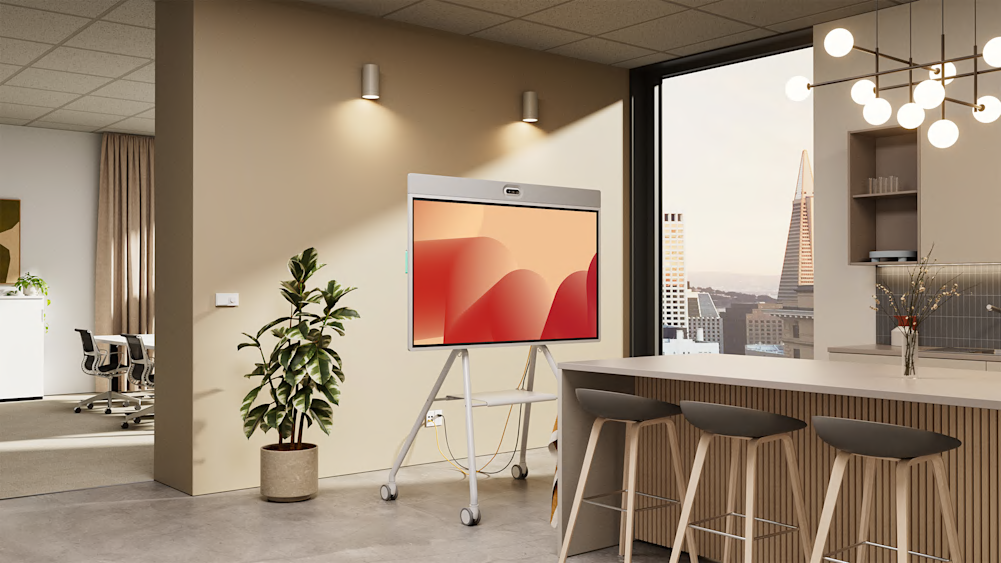
Rally Board 65 on a cart can easily be moved between spaces.
By implementing tools like these, organizations can create flexible, functional environments that draw employees back to the office and empower employees to work in ways that suit them.
Room and desk booking simplicity
Efficient room and desk booking is at the heart of a seamless flex space experience. For flex desks, all that’s typically required is to book in advance (or ad hoc) and plug in a laptop to get going. Rooms and open spaces can be booked the same way, offering a simple laptop connection or dedicated device through which meetings can be joined. Booking systems like Logitech Desk Booking and Room Booking, available with Logitech Essential or Select service plans, enable better workplace usage and simpler booking experiences. For Logitech devices, like Tap Scheduler and Logi Dock Flex, Logitech Sync brings all of these features together while also unlocking usage insights and remote monitoring and management for IT. Interactive tools can also help employees meet and collaborate more effectively when on site. Solutions like Logitech View enables office navigation and booking by providing a real-time view of office layouts via a touch display. This provides an engaging way to find desks, spaces, and even coworkers using zoomable touch controls.
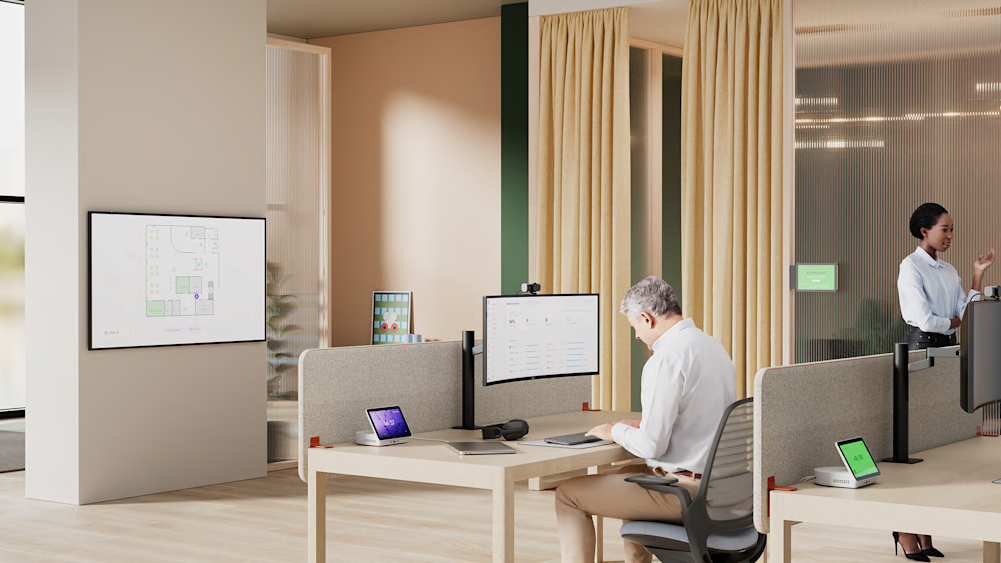
Logitech View, Logi Dock Flex, and Tap Scheduler in an open office space.
Effortless automation
With smart, integrated, and flexible solutions, workplaces are not only easier to navigate and more enjoyable to work in but are also capable of eliminating manual processes. Standalone sensors or those within devices can support workplace automation that carries out common actions automatically. Unique time-savers like these can make standard activities like reserving and freeing up spaces seamless. For instance, with Auto Book and Auto Release enabled through an Essential or Select license, the process is as simple as walking in or out of a room. When people are detected in a space, a reservation is automatically created. When those people leave, the reservation is removed. This works whether the room is being used for a video meeting or an in-person session.
While seamless booking and automation enhance day-to-day interactions, sensors and intelligent devices have an additional yet equally important role to play in the modern workplace…
Easy access to office space insights
Optimizing office spaces requires actionable insights to guide workspace decisions. With accurate, real-time data, organizations can identify issues and carry out more informed space optimization. Smart workplace technology, including solutions with built-in sensors like Rally Board 65, supports this by collecting a wide range of information, from occupancy to environmental factors. Understanding which spaces are used (or overused) and those that aren’t can help pinpoint issues and provide a clear picture of the adjustments that will enhance efficiency and employee experiences. Meanwhile, room climate, air quality, and energy use measurements better equip organizations to detect issues and improve wellbeing and sustainability. For wider and more advanced input, dedicated presence and environmental sensors like Logitech Spot can be placed in lounges, meeting pods, and phone booths, as well as standard meeting rooms. This provides precise occupancy and environmental information to support the management of spaces over time, even those without existing technology. Access to more detailed environmental measurements, including CO2 levels and particulate matter in the air, contributes to maintaining comfortable, productive, and healthy work environments. By combining ease of use with actionable insights, these tools elevate the in-office experience, ensuring that businesses are equipped to adapt and employees can flourish in flexible working environments.
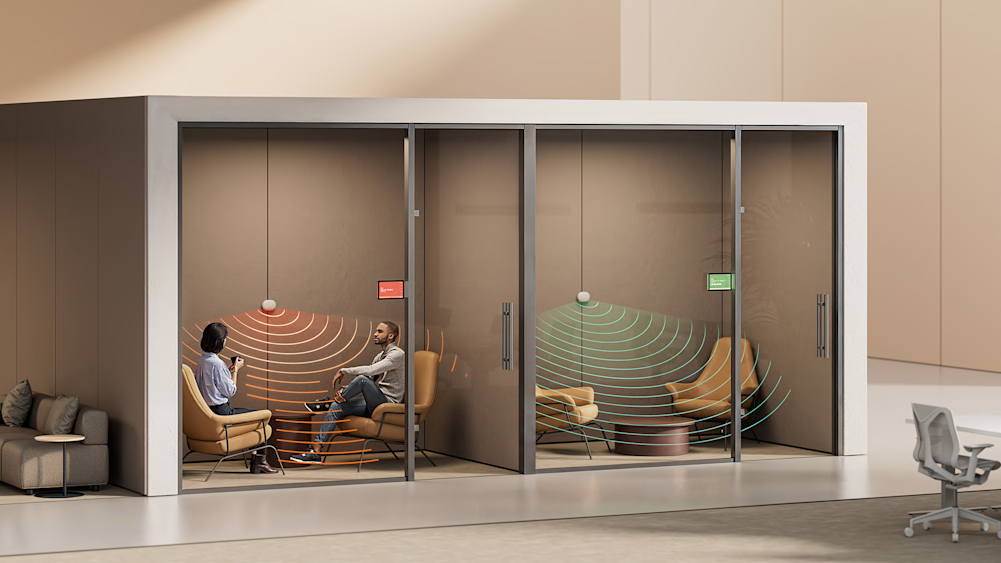
Logitech Spot occupancy and environmental sensor placed in meeting pods.
Embrace the modern workplace today
Across an integrated portfolio of solutions, software, and services from a single vendor, Logitech makes it easier to deploy workplace technology that makes a genuine difference to your employees and your business. We understand that creating a truly flexible and efficient workplace requires more than open areas and flex desks; it demands smart, intuitive tools that empower employees and optimize office resources. A smarter workplace enhances productivity and supports collaboration, making offices a joy to visit.
By adopting innovative approaches, leveraging data, and deploying the right tools, your business can create flexible, optimized spaces like these. A workplace that not only maximizes the value of your investments and adapts to shifting needs but also empowers your employees to thrive—because when employees are at their best, so is your business.
Read our ebook “Enhance Collaboration, Inspire Connection” for more inspiration on how to design workspaces that foster connection, collaboration, and creativity.
YOU MAY ALSO BE INTERESTED IN
Browse Categories: